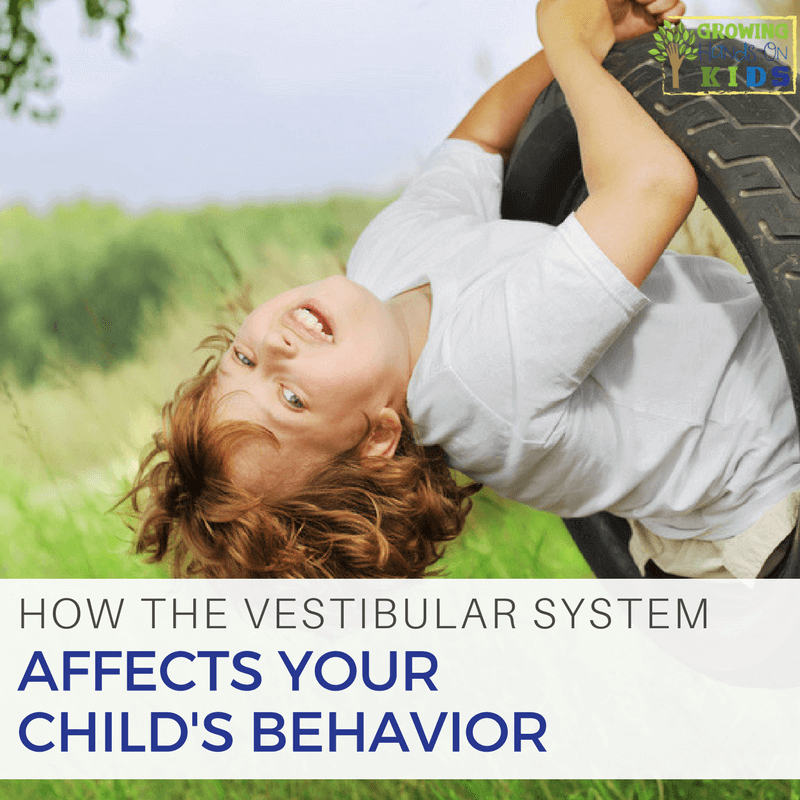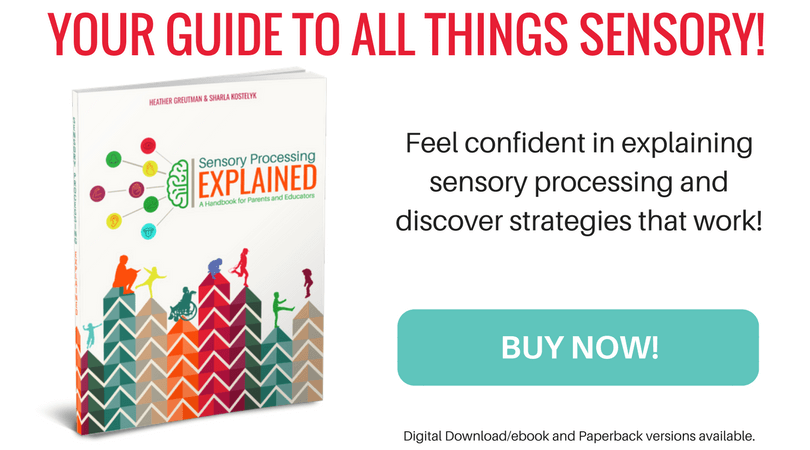The Best Activities for Vestibular Input
Affiliate and Referral links are used below to promote products I love and recommend. I receive a commission on any purchases made through these links. Please see my disclosure policy for more details. As an Amazon Associate, I earn from qualifying purchases.
The vestibular system is one of the sensory systems that can have the biggest effect on a child's behavior. Having a child complete a vestibular activity can help them regulate their emotions, focus, and gain their attention. Here are some of the best activities for vestibular input.
(Post updated Feb. 2023)
Table of contents
What Provides Vestibular Input?
Vestibular input comes from receptors in our inner ear whenever the fluid in our inner ear moves and touches the little hair follicles inside. The fluid moves and touches those hair follicles whenever our head moves. Here are some ideas for vestibular input seekers, or children who crave movement.
When working with a child with sensory processing challenges, vestibular input is where many Occupational Therapists will start, along with proprioception and tactile, as those three systems are the big three that many children and people struggle with.
Vestibular and proprioceptive input can also provide the most calming and focusing responses for many children. This is why many Occupational Therapy practitioners will start with vestibular and proprioceptive input.
What is Vestibular vs Proprioceptive Input?
If we are going to talk about vestibular processing, we have to also mention proprioceptive input as these two systems are tied closely together. After all, you need your muscles and joints in order to move.
Proprioceptive input is just that, sensory input coming from the muscles, ligaments, tendons, and joints in the body. Proprioceptive input includes many of the movement activities I'm going to mention below.
You can read more about the proprioception system here.
Vestibular Seekers And Avoiders
Before we get into the best activities for vestibular input, I wanted to address vestibular seekers and avoiders.
You may know a child who is constantly seeking out movement, swinging from the rafters as it were. They fidget, have a hard time focusing without moving, or need a lot more movement than other children their age. They crave spinning, jumping, and moving their bodies in as many ways as they can. They often show no fear of heights or other activities that might intimidate or “scare” many of us. This would be considered a vestibular-seeking behavior.
Or you may know a child who is afraid of their feet leaving the ground. They are afraid of heights and avoid fast movements such as swinging or spinning. They don't enjoy movement and would rather avoid any activity that requires a lot of it.
We all have these vestibular seeking or avoiding tendencies with different activities. All children avoid or seek out a vestibular activity throughout their day.
Children with sensory processing disorder or difficulties struggle to maintain that just-right level of arousal because their brain is not interpreting or organizing the sensory input appropriately.
A child with seeking tendencies is not able to function unless they get the input they need. A child who avoids struggles with day-to-day activities because of these avoiding reactions and behaviors.
I'm going to share ways that you can include vestibular input for seekers and also avoiders below. And keep reading for a list of vestibular activities that are great for both seekers and avoiders.
Vestibular Input Activities for Seekers
|| SPINNING
Spinning is the fastest and strongest way to get vestibular input. You also have to be very careful with it as many children become overstimulated quickly. Overstimulation from spinning can have many adverse effects such as getting sick and throwing up. Those with heart conditions or seizure disorders should also avoid spinning unless directed by their doctor.
My kids spin themselves on our swings on the playset in our backyard. We have a rule with spinning that they must spin in both directions (clockwise and counter-clockwise) and no more than 10 rotations at a time.
After intense spinning, it is important to have your child ground their body again. This can be done by jumping up and down in place with the hands placed on top of their head and pushing down on their head while jumping. This is also great to remember if a child becomes overstimulated with spinning and shows signs such as red cheeks, feeling sick to their stomach, fainting or dizzy, etc.
To read more about the effects of spinning, check out this post from A Sensory Life.
|| HANGING
Hanging can also be great for proprioceptive input (input through the muscles and joints for body awareness). Children who are vestibular seekers can benefit from hanging upside down.
You can do this on monkey bars, laying on the couch and hanging upside down, rope climbing, etc. A ninja course would also be great for this.
|| SCOOTER BOARDS
Children who crave vestibular input will love scooter boards. We found some nice ones at Aldi while grocery shopping one time.
Seekers may need something a little more daring with their scooter boards to get the input they need. You can have them ride down a small hill on them or crash into a crash pad with them.
One rule we always have is that you have to be on your stomach or sitting on your bottom. Depending on the activity, you may need a helmet. Get creative and come up with your own obstacle course or have a scooter board race.
|| CLIMBING
Rock climbing, rope courses, monkey bars, and tree climbing, are all great options for vestibular seekers.
|| OBSTACLE COURSES
If you've ever watched America Ninja Warrior, these types of obstacle courses are perfect for children who are vestibular input seekers.
My husband built floating steps out of plywood for ours and we also use a homemade balance beam and purchased a ninja rope course.
You can find a DIY Ninja Course tutorial here.
|| BALANCE BEAMS
Seekers may want to take more risks with balancing. Finding safe ways for them to get the input they need will be key. Stepping stones at varying heights are a great option, or balancing on playground equipment is also great.
|| TRAMPOLINE
Jumping on a trampoline is a great way for vestibular sensory seekers to get the input they need. It can be a large outdoor trampoline or an indoor one.
|| SWINGING
Many children who are vestibular seekers crave the rhythmic movement that swinging provides. This can include a playground swing or a swing that you can set up in your doorway. If you have a space where you can place a hook in the ceiling beam, hanging one from the ceiling is also a great option. Be sure to follow all safety guidelines for the swing installation.
Vestibular Input Activities for Avoiders
These are some ways you can adapt popular vestibular activities for kids who tend to avoid vestibular input.
|| SWINGING AND SPINNING
Children who are sensory avoiders may avoid swinging and spinning. Never force a child to do these activities, but you can gently introduce them so their sensory system begins to tolerate movements like it.
Gently push a child on a platform swing or a swing that is low to the ground so that their feet can touch the ground. You can also have them sit on your lap as you gently swing back and forth with your feet on the ground. Platform swings are a great option for vestibular avoiders as it gives them a greater base of support and they can feel more secure on them. Hammocks would also be a great, cost-effective version of a platform swing.
For spinning, you can purchase a sit-and-spin or have them lay on a scooter board on the floor so they have more control over the pace of the spinning. Remember to have them spin in both directions. Even one rotation can be a huge benefit.
|| WHEELBARROW WALKING
Another great option for vestibular avoiders. Have the child put their hands on the ground and gently lift their legs behind them so their weight is on their hands. An avoider may not like their feet up off the ground, so you could have a pillow or stepstool nearby to place under their feet. This will give them the effect of their weight being at the front but still supported from behind.
This activity is a great way to gradually get a vestibular avoider to put their head in a different position than just being upright. And it doubles as amazing proprioceptive input through the joints and muscles.
Gradually work up to the child taking a few “steps” on their hands while you support their legs.
|| SCOOTER BOARDS
For an avoider, just sitting or laying on the scooter board while it moves slowly be may enough input. You can also include it with some other fine motor activities as I did with this obstacle course set up in the hallway at one of our schools.
|| BALANCE BEAMS
An avoider may not like their feet off the ground. You can begin by walking a line using painter's tape or a rope on the ground.
|| LOG ROLLING
Do you remember as a child laying down in the grass on a hill and just rolling down it? This is exactly what I mean by log rolling. It doesn't have to be on a hill though and if you have a vestibular input avoider, I would start on a flat surface first.
You can also have your child roll up in a blanket to log roll which will give them some added proprioceptive input while they roll with the deep pressure from the blanket, helping them feel more grounded.
|| SLIDES
Some children who avoid vestibular input may also be afraid of heights. This makes sense since their feet are off the ground and they feel dysregulated.
You can begin introducing slides by using a small child's slide and have them slide down into a ball pit or onto a crash mat. Even just standing on the first rung of the steps to go up the slide is a start.
More Activities for Vestibular Input
Many of the activities below are great for vestibular seekers and avoiders. Seekers will need longer-lasting input with higher intensity. Avoiders may only tolerate a few seconds of the activity. Follow your child and look for any signs of overstimulation.
- yoga poses (especially great for avoiders!)
- dancing
- jumping rope
- rolling down a hill (a great way to start with avoiders)
- somersaults
- cartwheels
- gymnastics
- walking the line (use painter's tape on the floor in a straight or zig-zag line)
- play Twister
- climbing and sliding at the playground
- do a handstand
- riding a bike
- swimming
- using a ball chair or wiggle cushion for seated activities
More Resources for Vestibular Input
Need some more ideas for vestibular input? I've gathered some links to other helpful resources. You can also find some of my favorite vestibular input equipment and tools below.
Sensory Processing: The Vestibular System – The Inspired Treehouse
45 Essential Vestibular Activities And Input Ideas – Your Kids Table
Juperbsky 8ft Balance Beam for Kid's Gymnastics Practice – Folding and Easy to Store, Non Slip – Floor Gym Equipment for Teens Hone Skills at Homeedx Education Step-a-Logs – Balance Beam for Kids – Indoor and Outdoor – Stackable – Build Coordination and Confidence – Physical and Imaginative PlayStrider – 12 Sport Balance Bike, Ages 18 Months to 5 Years, BlueGonge HILLTOPSGonge RiverstonesSwing-N-Slide WS 4861 Nest Swing 40Royal Oak Giant Platform Tree Swing, Bonus Flags, 700 lb Weight Capacity, Easy Install, Steel FrameOnCloud Hanging Hammock Chair Porch Swing (Green)Wise Owl Outfitters Hammock Camping Double & Single with Tree Straps – USA Based Hammocks Brand Gear, Indoor Outdoor Backpacking Survival & Travel, Portable SO NvyBluMoluk Bilibo BluePlayskool Sit ‘n Spin Classic Spinning Activity Toy for Toddlers Ages Over 18 Months (Amazon Exclusive)Ninja Slackline Monkey Bars Kit, 42” Jungle Gym Obstacle Course for Kids and Adults + Climbing Rope, Warrior Training Obstacle Course Equipment, Slackline Gymnastic Bar, Tree Protector & Carry BagSlsy Ninja line Monkey Bar Kit 40 Foot, Kids Slackline Hanging Obstacle Course Set Warrior Training Equipment for Backyard Outdoor Playground, with Gym Rings, 440lb Capacity, Carrying Bag
You May Also Like:

Heather Greutman, COTA
Heather Greutman is a Certified Occupational Therapy Assistant with experience in school-based OT services for preschool through high school. She uses her background to share child development tips, tools, and strategies for parents, educators, and therapists. She is the author of many ebooks including The Basics of Fine Motor Skills, and Basics of Pre-Writing Skills, and co-author of Sensory Processing Explained: A Handbook for Parents and Educators.


















